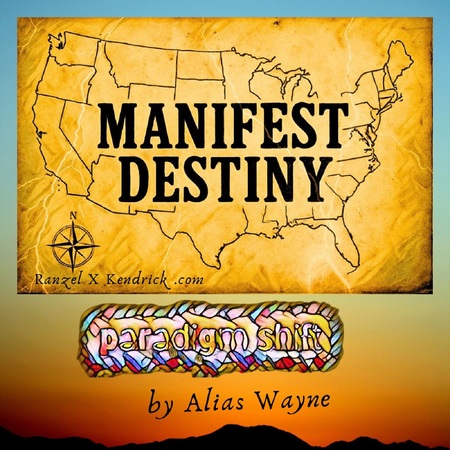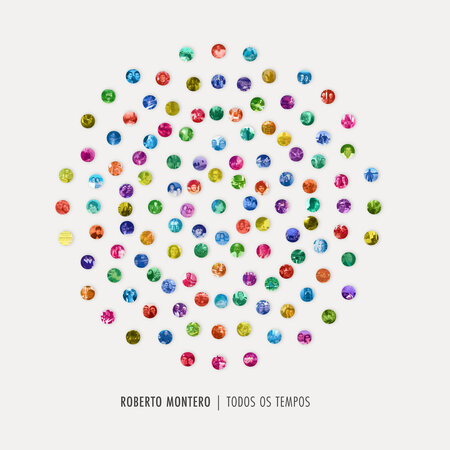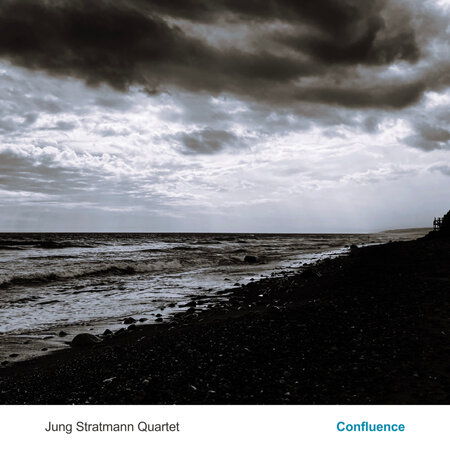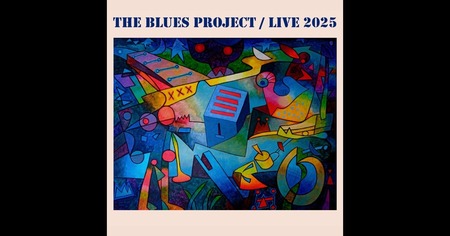Jeff Dingler Presents “How About You?”

With “How About You?,” bassist Jeff Dingler delivers a quietly confident instrumental jazz album that finds fresh perspective in familiar territory. Built around a classic guitar–bass–drums trio, the record revisits well-known standards and a handful of bop-oriented pieces, but reframes the upright bass as a melodic, leading voice rather than a supportive one.
The instrumentation is deliberately lean, and that sparseness becomes one of the album’s strengths. Dingler’s upright bass sits at the center of the sound, frequently stating
themes, shaping transitions, and carrying solos with a lyrical, almost vocal phrasing.
Guitarist Tom Dempsey works less as a dominant front-line soloist and more as a conversational partner, alternating between warm comping, single-note counterlines, and understated harmonic commentary. Drummer Joe Brown Jr. completes the trio with taste and restraint, allowing the music to breathe naturally.
https://open.spotify.com/embed/album/4XDBBJwRGqcLJrGw6BsjLh
Production choices reinforce the album’s intimate character. The recording is warm and uncluttered, with an emphasis on acoustic detail rather than studio polish. Guitar and drums are placed slightly behind the bass in the mix, creating a sense of depth that mirrors the trio’s musical hierarchy.
As an instrumental jazz record, How About You? succeeds by valuing interaction and nuance over sheer virtuosity. The arrangements avoid gimmicks, relying instead on shifts in role, texture, and pacing to keep the standards engaging.
Several tracks stand out for how effectively they illustrate this approach. The title track, “How About You?,” sets the tone early, with Dingler’s bass confidently outlining the melody while the guitar and drums provide buoyant support. “Embraceable You” emerges as one of the album’s emotional highlights, stretching out into a spacious, reflective ballad where the bass sings with patience and warmth. On the up-tempo side, “Dewey Square” brings a sharper, bebop-inflected edge, showcasing the trio’s rhythmic precision and collective swing.
https://jeffdingler.hearnow.com/
Ultimately, How About You? is a record that rewards careful listening. Its pleasures are subtle rather than immediate, rooted in tone, balance, and conversation. For listeners drawn to intimate, thoughtfully arranged instrumental jazz, this album makes a strong and quietly persuasive statement.
Mountain Climer Presents “Every Other Weekend”

With “Every Other Weekend,” Mountain Climer delivers a quietly affecting indie-rock single that’s emotionally impactful without dramatic gestures. Written years before its eventual release, the song carries the weight of lived experience; exploring separation, shared parenting, and emotional distance through carefully chosen details.
Lyrically, the song centers on the emotional mechanics of a fractured family life. The title phrase becomes a symbol of compromise and routine, reflecting the difficulty of taking responsibility for and coming to terms with separation.
Rather than framing the narrative through anger or bitterness, Climer adopts a reflective tone, and the lyrics feel observational in their approach. There’s a sense of genuine regret here that allows the emotional resonance to emerge naturally. This understatement gives the song its poignancy, especially in how it acknowledges the presence of children and the careful emotional boundaries that come with that reality.
Musically, “Every Other Weekend” sits comfortably within the indie-rock genre, with subtle cues like melodic guitar lines, a steady, unhurried rhythm section, and an overall warmth that favors organic textures over polish. The arrangement never overwhelms the story, instead acting as a framework that supports the song’s emotional arc.
Instrumentation plays a key role in shaping that intimacy. Guitars are clean and purposeful, offering recurring motifs that gently anchor the verses while the synths add a soft, almost pastoral layer beneath the choruses. Piano textures and understated bass lines deepen the harmonic palette, while the drums remain measured and expressive.
“Every Other Weekend” is about absence as much as presence: the spaces between visits, the things left unsaid, and the emotional recalibration that comes with shared custody. That thematic maturity places the single above simple breakup songs, positioning it instead as a meditation on responsibility and quiet loss.
“Every Other Weekend” stands out as a thoughtful, emotionally grounded release. Its strength lies in its balance between lyric and arrangement that trusts the listener to lean in to enjoy its depth and sincerity. For listeners drawn to narrative-driven indie music, this single offers a resonant and rewarding listen.
https://www.instagram.com/mountainclimermusic/
El Drifte Presents “Here the Holidays Is” b/w “This Year (Wishing You Were Still Here)”

El Drifte’s two-song holiday drop, released as Holiday Songs earlier this November, is a short, smart one-two that showcases both the goofy, party-ready side of seasonal music and the quieter, ache-filled tradition of holiday ballads.
The pairing feels deliberate: an inclusive, rollicking opener that invites everyone in, followed by a tender elegy for absence that refuses to sentimentalize grief. Together they make a tiny, well-rounded holiday single that sits naturally in El Drifte’s wheelhouse of country/honky-tonk songwriting.
“Here the Holidays Is” is a singalong, communal country-pop number with a vintage sheen that is built around a deceptively simple, inclusive lyric concept: the holiday as a communal, non-judgmental party. The phrasing is conversational, the hooks immediate, and the chorus lines are made for you to sing along to.
STREAMING:
VIDEO (for track 1 “Here the Holidays Is”):
VIDEO (for track 2 ” This Year (Wishing You Were Still Here”:
“This Year (Wishing You Were Still Here)” is a slowly unfolding piano ballad that recalls classic seasonal standards that find meaning in longing rather than revelry. It’s the songwriting flip side to the previous number, with a classic and circular melody that gives the lyric space to breathe. It anchors feelings in concrete details like the empty chair, so the sadness feels earned and specific.
Both songs were recorded at Welcome to 1979 in Nashville and were recorded and mixed by Jeremy Bernstein. The production on both tracks is clean, organic, and tasteful; taking a classicist tone without sounding antique.
El Drifte’s two holiday singles are smartly conceived and well executed. One festive, inclusive anthem with a catchy chorus and bright, old-timey production is put together with its emotional counterweight: an empathetic, well-crafted ballad about loss and memory. Together they make for a compact holiday release that both longtime fans and casual holiday-playlist listeners can enjoy.
ONLINE:
https://eldriftemusic.com/
https://www.facebook.com/eldrifteofficial
https://www.instagram.com/eldrifteofficial
https://eldrifte.bandcamp.com/
Alias Wayne Presents ‘Manifest Destiny’ off the upcoming album ‘Paradigm Shift’

With “Manifest Destiny,” Alias Wayne stakes his claim not just to another single release but to a broader artistic evolution. a sprawling, alt-indie-tinged anthem, this track arrives at over 6 minutes, this track demands patience from listeners, but offers layered sonic textures and incredible thematic depth in return.
“Manifest Destiny” dwells in the fertile borderland between alt-indie, Americana, and country-rock. Rather than conforming to strict genre boundaries, the song blends organic instrumentation with soulful vocal interplay. The rock and blues influences give the track an expansive feel that feels almost cinematic.
From its opening chords, the production favors warmth and space. Male and female vocal harmonies intertwine, lending a dialogic dynamic to the lyrical narrative; a stylistic choice that elevates the emotional resonance.
Lyrically, Wayne’s latest effort leans into poetic reflection. While song titles often nod to grand ideas, here the metaphor of manifest destiny, historically tied to ideas of expansion and potential, becomes a contemplative anchor for personal growth and existential uncertainty.
STREAMING:
VIDEO:
This lyrical ambition isn’t without risks. The extended runtime allows the song to drift, and additions in texture don’t quite resolve into clear progression. Yet this very spaciousness also gives the track its potency: Wayne isn’t chasing hooks as much as he’s cultivating atmosphere.
The production on “Manifest Destiny” is one of its most striking features. The arrangement grows organically with layers of acoustic and electric textures including backing vocals and mid-song dynamic lifts. Crucially, the choice to blend acoustic grounding with subtle alt-indie flourishes creates a sonic canvas that feels both immediate and expansive.
“Manifest Destiny” is a bold, atmospheric single that showcases Alias Wayne’s evolving thoughtful and textured artistry. For longtime fans, the song offers familiar lyrical earnestness and emotive vocal delivery, now wrapped in bigger structural ambitions.
ONLINE:
https://www.ranzelxkendrick.com/
https://www.instagram.com/ranzelxkendrick/
https://www.facebook.com/RanzelXKendrick
eM Gives You ‘The Sweetest’ EP

The multifaceted artist from Down Under, eM, is back with an exciting new release that is ‘The Sweetest’ one yet! eM is an accomplished vocalist, producer and now author and she is one resilient and dedicated musician. This latest project is one of eM’s most ambitious to date stating that it was one of the most technical recordings she has ever worked on.
With elements of pop, dance club hooks and house music, ‘The Sweetest’ features four stunning tracks all produced with the utmost precision. With plenty of vocal parts & dubs, eM mixed and mastered this record twice. The persistence and hard work paid off because ‘The Sweetest’ is a smashing success in my book!
I kick things off with “I’m Not Waiting For You” and it’s safe to say that it is time to groove to the Hypnotik sounds of eM! With a mysterious sensation in place, eM proves that she is in charge and not stalling for anyone on “I’m Not Waiting For You”. Time is eM’s friend, so jump aboard and embrace “I’m Not Waiting For You” while you still can! Next, we hear “Sweetest Thing” and the listener will get a heavy dose of stellar vocals along with a spicy hook to boot. This recording sounds like the “Sweetest Thing” ever as this track is simply sizzling and eM is on fire! “Swinging Door” provides a futuristic sound that is out of this world! eM delivers space-age music to bounce to on “Swinging Door”, so brace yourself for an incredible voyage. Traveling through this vast audio galaxy, eM provides an interstellar production for the ages on “Swinging Door”. It is also worth mentioning that “Swinging Door” includes the guitar work of Nat Russell adding a nice touch ‘n’ tone overall.
Be sure to SKOPE out the official video short for “Swinging Door” right here: https://www.youtube.com/shorts/rrilaRIhdnM.
“Time With You” is another solid installment to this EP as eM proves she is a highly skilled musician who is on a mission to be the absolute best at her craft. I love the effects on “Time With You” as they really POP and make your ears smile with joy. With a fulfilling beat that doesn’t quit, eM delivers a soul-stirring performance on “Time With You”.
I am thoroughly impressed with eM’s efforts on this new release because I sense that this project was a tough labor of love. eM has persevered and has created an EP that is technically sound from start to finish. The reward is ‘The Sweetest’ deal here for eM because the end result is a big HIT! Audiences and fans alike will be delighted to hear ‘The Sweetest’ sounds around courtesy of the multitalented eM.
Be sure to add this great EP to your playlist NOW and allow eM to entertain you! https://open.spotify.com/album/2QpCnQEkl0nOqSFLDy7r2K
—
https://www.youtube.com/@mzzemmusic/shorts
https://www.tiktok.com/@mzzemmusicaus?_r=1&_t=ZS-91Gu1MKSKG2
https://www.instagram.com/mzzemmusic/
By Jimmy Rae
Roberto Montero Presents “Todos os Tempos”

On “Todos os Tempos,” guitarist–composer Roberto Montero steps confidently into the spotlight with a debut that feels less like an opening statement and more like the culmination of a lifetime of listening. Self-produced and meticulously arranged, the album treats Brazilian music not as a fixed tradition but as an evolving language complete with contemporary jazz harmonies, chamber-like textures, and an unhurried melodic clarity.
From the outset, what stands out most is how carefully the album sounds. The production is warm, spacious, and deliberately organic. Montero resists the temptation to over-polish, and instead, he leans into the tactile qualities of his instruments. You hear the grain of the acoustic guitar, the soft bloom of the Rhodes, and the wooden resonance of hand percussion.
https://robertomontero.bandcamp.com/album/todos-os-tempos-all-tempos-all-times
The instrumentation reinforces this sense of intimacy as Montero alternates between acoustic, electric, and synth-inflected guitars. The small ensemble darts between folkloric gestures and modern jazz voicings with ease. The arrangements emphasize interplay as guitar and piano trade motifs like conversational partners, while bass and percussion gently propel the frame.
The eight-minute opener, “Igarapé/River stream,” serves as a thesis statement for the album. Built on slowly expanding layers of piano, percussion, and lyrical guitar lines, the piece evolves like a river journey: serene, patient, and subtly dramatic. The production emphasizes space, allowing small gestures to accumulate into a cinematic whole.
In contrast, “Valsa do Tempo Parado” clocks in at under two minutes, and this miniature waltz is one of the album’s most affecting moments. Its simplicity is its strength: a restrained guitar figure, delicately voiced harmonies, and a mood of quiet reflection.
The closer, “Vou Mas Fico,” is a showcase of the album’s melodic strength. It’s a strong instrumental interplay that focuses on creating an atmosphere of introspective calm.
Even at its close, the album expands its palette without ever losing its cohesive tone.
Todos os Tempos is not an album that clamors for attention. Instead, it unfolds patiently, offering tranquility, warmth, and a surprising emotional depth. Montero’s restraint is part of his artistry: every flourish feels earned, every silence meaningful. In a landscape crowded with showy debuts, his is refreshingly confident in its subtlety.
https://www.robertomontero.com/
The Stomp’n Ramblers Presents ‘Kick’n Stones’ Album

Written in the strange aftermath of the pandemic when guitarist/vocalist Owen Mancell and harmonica player Ryan Stone were sending song ideas across coastlines, “Kick’n Stones” bears the fingerprints of reconnection. The duo reunites as the Stomp’n Ramblers to deliver a raw, roots-soaked blues record that’s steeped in tradition and sharpened by lived experience.
Recorded primarily at Damien Gerard Studios, the album intentionally avoids overpolish, leaning into the warmth and grit of live performance. The mixes preserve breath, slide noise, and the air between instruments: all the small imperfections that give blues its humanity. It’s the kind of record you’d hear in a smoky back room, where the stomp box thuds like a second heartbeat and the harmonica cuts through the mix like a weathered story.
The album gets its character from Mancell’s slide guitar and Stone’s harmonica, which weave in and out of the vocals with a sense of conversation. The vocal delivery is classic blues, full of grit and raspy undertones. The minimalist setup forces each musical gesture to matter and to the duo’s credit, it does.
Lyrically, the album blends time-honored blues themes and the title track, “Kick’n Stones” is a great example of this. It captures everything the band set out to do with its themes of wandering and letting go of plans and attachments, while a harmonica swirls around Mancell’s voice. It’s classic, road-worn blues with modern clarity.
“Politician” is perhaps the album’s sharpest lyrical moment. Short, punchy, and unflinchingly direct, it breaks from the personal storytelling and aims outward; proof that the band can deliver contemporary critique without losing their identity.
At over five minutes, the closing number, “Last Kiss Goodbye” is the album’s most expansive track. With a classic story of heartbreak and regret, the Ramblers stretch their legs here, delivering more emotional depth and a bittersweet, lingering finish that closes the record with genuine resonance.
Kick’n Stones is a confident, fully-formed blues album from a duo who know exactly what they want their music to feel like: raw, human, and deeply connected. For fans of authentic roots blues, The Stomp’n Ramblers have made one of the year’s standout independent blues releases.
Streaming Link
https://ffm.to/sr-kicknstones
https://www.facebook.com/thestompnramblers
Les Fradkin Presents ‘Mr. Midi Guitar’

With his latest album “Mr. MIDI Guitar,” Les Fradkin continues to push the boundaries of experimental music by reinterpreting baroque and classical instrumental music with his Starr Labs Ztar as the centerpiece. This is not just an attempt to replicate the classics, but to channel their melodies, harmonies, and rhythms through the sonic filter of modern technology.
Having long established himself as a pioneer of MIDI guitar Fradkin treats the Ztar not merely as a guitar substitute, but as a solo orchestral engine. On this album, synths and mellotron fill in for full orchestral ensembles to present the works of Vivaldi, Pachelbel, Beethoven and many more in a completely new light.
When you listen to Mr. MIDI Guitar, you’re rarely hearing traditional guitars in the conventional sense. Fradkin uses the Ztar to control a variety of sounds, including strings, keyboards, and sometimes percussive elements; effectively letting him mimic rhythm, lead, and even ensemble textures simultaneously.
Fradkin’s reinterpretation of Pachelbel’s Canon in D is the first standout moment of the album, as it effectively turns a piece that is often used as wedding music into a work of orchestral rock.
Bandcamp – Mr. Midi Guitar:
https://lesfradkin1.bandcamp.com/album/mr-midi-guitar
“Summer” from Vivaldi’s Four Seasons is another strong example of bridging classical source material and modern instrumentation. The melody and structure remain intact, yet the instrumentation recasts the piece in a futuristic light, making it feel nostalgic and novel at once.
Among the closing tracks, “Ode to Joy” stands out with Fradkin setting Beethoven’s magnum opus to the beat of a march on percussion while replacing the main string-driven theme with his Ztar. The result is an absolutely rocking delivery that pays homage to Beethoven’s innovative spirit.
Production-wise, the album is arranged to give fullness and dimension despite being crafted by one person. What’s interesting is how this approach changes the emotional impact of classical pieces. Because timbres are synthetic, there is sometimes a slight distance that can feel both compelling and curiously removed from the emotional rawness of live classical performance.
Mr. MIDI Guitar is a bold, creative rethinking of classical and baroque repertoire through the lens of the Ztar. It’s a record for curious listeners: those open to hearing old masterpieces in a new light. If you approach it with an open mind, the album rewards you with glimpses of what classical heritage might become when filtered through modern creativity.
– https://www.reverbnation.com/lesfradkin
Camille K Present “Lonely” Featuring M11SON

Camille K leans into pure, effervescent pop on “Lonely,” a sleek single that trades some of the raw power of her earlier work for a brighter, radio-friendly gloss. Produced by Sakred Wolves and featuring collaborator/producer M11SON, the track is a concisely crafted piece of modern electro-pop with its shimmering synths, tight mid-tempo pulse, and a hook that’s engineered to stick.
Despite its electro-pop arrangement, the track never goes into club-like maximalism, taking a character that’s a bit more like sunlit synth-pop with a little danceability. The arrangement opens on a crisp, driving beat together with whispery harmonies and bright, ear-candy accents.
The track is characterized by an interplay between understated verses and a buoyant, singalong chorus with a delightfully catchy refrain in the lines “You’ll never be lonely again/I will keep on holding/I will keep on holding your hand.” The ebb and flow of the verses and chorus is the strongest part of the song’s character, making it ever the more memorable.
– https://music.apple.com/us/album/lonely-feat-m11son-single/1851134233
While the title implies a track about loneliness, it’s actually pretty misleading as the lyrical content is actually about the electric, fluttery ache of new attraction; the honeymoon jitters rather than despair. Camille’s lyric lines favor immediacy over metaphor, which makes the song feel conversational and very shareable.
Vocally she’s polished and expressive here, and rather than stretching for showy moments, Camille uses texture and subtle dynamics to sell the emotion. Sakred Wolves’ production keeps the track propulsive without ever sounding cluttered, highlighting the synth flourishes, and adding depth with tasteful vocal layers.
M11SON’s presence gives Lonely an extra textural touch, especially on the final verses. However, his contributions are used sparingly, with the goal of broadening the song’s sonic palette without diluting Camille’s lead identity. The result is a polished, contemporary pop track that’s ready for both radio rotation and short-form video use.
If you like bright, feel-good pop with polished production, Lonely definitely belongs on your regular rotation. It’s less a reinvention than a refinement: with Camille K trading some rough edges for streamlined pop sheen, showing that she’s a singer who can sell both intimacy and a hook.
“American Drifter” by Jacob Jones

American Drifter is an eight-track EP by country artist Jacob Jones (serving as a prelude to a 21-song release set for 2026), consisting of the first wave of music setting the tone for his longtime passion for patriotism. These good songs all resonate with anyone who’s been through the military or grew up around that lifestyle of moving around a lot, and everything that comes with it. It’s no surprise Jones takes after his father with these topics and gives a look into his experience from the son of a military man’s perspective, unveiling more about the artist from previous releases in his catalog.
FACEBOOK: https://www.facebook.com/JacobJonesCountry
As mentioned, being the “Son of a Military Man” is where it all starts, with a song about of a drifter of this sort, which immediately tackles the album title and concept. This proper opener takes the listener on the start of a journey from Tacoma to Alabama and all points in-between, without detailing too much for the sake of song, keeping it simple but strongly exemplifying the point. Most of the song titles are pertinent to the subject matter of being raised by a military parent, with “The Fallen Stood” is a song about falling for the greater good and standing for something, and this is where Desert Storm gets a mention.
“Even Heros Need Saving” is a ballad changing the tempo somewhat with a story about heroes and the pride set aside to fight for serving, and what they sacrifice across the board, including relationships, family members and friends on top of duty. But the tempo kicks back up a notch on the folkish “Another Angel” turning out to be one of the more compelling songs on American Drifter, and where the songwriting of Jacob Jones really shines.
“September 12th” is the sixth song, and it’s not hard to guess what the title is about, which is something that happened the day prior we’ll never forget. The world hasn’t been the same since that fateful day, no matter where you live, and it’s a heartfelt based around it and the next day’s aftermath. American Drifter continues with “Homeless Man” somehow appropriately following with a moment to step into the shoes of a vet with no address, and how reflection on their service should always be in mind and thanks always given. This song also shows a rocking side of Jacob Jones with some intricately hot guitar parts.
https://open.spotify.com/album/0deQ5vcEvIU4wLOGlQacyt
“Over A Beer (feat. Michael Warren” plays like a solution to everything from friends in need to catch up over lost time and open opportunities to heal, and even to celebrate the lives of those we lose. Everything on American Drifter is arranged and placed so well it plays like a story, albeit only the starting of what’s to come. And the final track puts the icing on the cake for this release, with “Tears on my Dogtags” reminding of the entire subject of military life and the stories it inspires, told in the image of a soldier, backed soft acoustic guitar lines.
Gwen Waggoner
Yellow Majesty Presents “APHANTAZIA”

Gothenburg-based artist, producer, and informatics professor Amir Haj-Bolouri makes a powerful statement with “APHANTAZIA,” his 14-track debut album under the artistic persona, Yellow Majesty. At once cerebral and visceral, the album fuses hard-edged alternative rock with electronic textures, philosophical inquiry, and a cinematic sense of scale.
Rooted loosely in alternative metal, grunge, and atmospheric electronic rock, APHANTAZIA draws its sonic identity from contrasts. Guitars swing between clean, spacious lines and distorted eruptions; drums land with disciplined weight; and synths smear the edges, lending the album its hypnotic, often surreal ambience.
– https://skopemag.com/2025/12/07/new-album-yellow-majesty-releases-debut-album-aphantazia
The album’s conceptual backbone is its title: aphantasia, the inability to form mental images. In Yellow Majesty’s hands, it becomes a metaphor for the fraying relationship between modern humans and their own reality. These songs circle themes of illusion, desire, technological entanglement, embodiment, and the fragile search for meaning.
“YOU ARE AN IDIOT” stands out among the early tracks, with its raw, confrontational vocals steeped in distortion. This track channels a post-punk immediacy into the album, and its abrasive energy provides a necessary counterpoint to the more reflective compositions.
“STALKER” is a darker and more rhythmic highlight that blends electronic pulses with grinding guitars. It embodies the album’s fascination with surveillance, identity, and the uneasy intimacy of digital life.
The title track, “APHANTASIA,” is a seven-minute centerpiece that functions as a thesis statement. It begins in near-stillness, with a sparse guitar intro with whispered vocals gradually layered in before rising into a towering, cinematic climax.
While the compositions often embrace largeness, the performances remain deeply personal, which is unsurprising given that every song is written, performed, and produced by Haj-Bolouri himself. The result is a world that feels handcrafted down to the last detail.
Yellow Majesty’s debut is a thematic and sensory journey that asks listeners to confront the fragility of presence and the cost of losing our inner landscapes. APHANTAZIA is ambitious and immersive; a striking first chapter from an artist who has already built a world worth returning to.
https://www.instagram.com/yellow.majesty/?hl=en
https://www.facebook.com/yellowmajesty/
Jung Stratmann Quartet Presents “Confluence”

Long-time jazz collaborators Sujae Jung and Wolf Robert Stratmann return with a sharp, intimate, and quietly ambitious project in “Confluence,” the latest release from the Jung Stratmann Quartet. Together with guitarist Steve Cardena and drummer Marko Djordjevic, the group delivers five original pieces inspired by nature and the unifying spirit of jazz music.
What stands out immediately is the conversational balance between the four players; Jung’s touch on piano is both lyrical and skeletal while Cardenas uses that space to color the edges with subtle harmonic inflections. Stratmann’s bass is often the narrative spine: melodic when called for, but also driving the tracks with forward momentum.
https://jungstratmann.bandcamp.com/album/confluence
https://www.sujaejungmusic.com/
Djordjevic’s drumming functions more as architecture than ornamentation, with an uncanny sense of measured restraint that lets silence be as important as sound.
This album favors space over flash, with melodies that breathe and grooves that arrive without force. Confluence sits in modern chamber-jazz territory, borrowing the lyricism of contemporary European jazz, and occasional impressionistic touches that nod toward ambient or minimalism.
The album opens with “Tree Huggers,” a bright number with a memorable motif and showcases Jung’s gift for balancing simplicity with subtle harmonic shifts. “This Wine Tastes Very Dry” is the centerpiece, with its elegant tension, spare ornamentation, and a directness that works as a metaphor for the record’s aesthetic. The album closes with “After Sunset,” a gentle and understated piece that perfectly captures the mood of dusk.
Structurally, the pieces often blur composition and improvisation. The album was recorded by Jason Rostowski during an exclusive live performance, and it retains that authentic character even in the digital release. The result is an EP-length program that moves between contemplative balladry and subtle rhythmic life without ever sounding disjointed.
Confluence is not a showy record meant to impress through fireworks. Instead, it’s an artful, tightly punched statement from a band that values listening as much as soloing. The record’s pleasures are cumulative, and the more you return to it, the more the quartet’s internal logic and the subtle rewards of their interplay reveal themselves. For listeners who appreciate chamber-like contemporary jazz, Confluence is a thoughtful and convincing listen.
https://www.instagram.com/sujaejung_pi/
BB Stevens Releases ‘Hoboken’

If you’re in the mood for something completely out of the norm and outside the box, then this new release by BB Stevens is your golden ticket. ‘Hoboken’ features 10 tracks and each one with its own flavor and identity. I like to refer to BB Stevens as a hyper original artist who plays to the tune of unconventional standards and I dig it!
BB Stevens is one creative soul who is the owner/manager of Mia Mind Music and is singer/songwriter, published novelist and entrepreneur. This multi-talented artist brings elements of alternative, americana and everything else under the sun on the new album. ‘Hoboken’ is full of surprises and songs that will capture your imagination.
Right out of the gates, BB Stevens is coming in hot with “2025” with an unorthodox style that catches your attention immediately. I am all ears as soon as I hit play and hear “2025” ringing in a new-age attitude. Next, the listeners are bouncing around everywhere on “Gravity” where there are no limitations. Moving along, step into a virtual world of altered rhythms and machine-like vocal patterns on “Artificial Intelligence”. BB Stevens takes a very unique approach on the following number, “The Future Backwards” where he is taking you on one wild ride, so buckle up! Track five, “Rainbow Connection”, offers a very colorful sound where you can sense the electricity in the air.
You can also SKOPE out the official music video for “Rainbow Connection” right here: https://www.youtube.com/watch?v=0BkVbDpDMYM.
BB Stevens is hitting you with a raw & edgy vibe on “Sexy Levi’s Jive” where your bones will be rattlin’ with this smoky joint. BB is supplying a hard-hitting beat & tone on “Accountability” and then providing some rockin’ energy on “I Don’t Need” that will get you pumped. It’s time to “Wake Up” your senses and enjoy a catchy groove that will hook you in and not let go. BB Stevens delivers some excellent storytelling on the closing number “The Magnificent Mr. Reder” where the words and melody will keep you enthralled throughout the entirety of the recording.
I respect BB’s artistic freedom and his vision to explore musical plateaus that have no boundaries. ‘Hoboken’ is released under Stryker/Virgin Records and is available on all streaming and digital retail platforms. BB Stevens gives the audience his genuine self and pure originality and that’s all you can ask for. Take a chance with ‘Hoboken’ and give your ears a healthy workout that they won’t soon forget!
https://open.spotify.com/album/2u9zg9pvGDDpFhC9raDqGU?si=cTK-5EaiR_qWQZ2fXBPANg
https://www.facebook.com/thebbstevens
https://www.instagram.com/_BB_Stevens_
By Jimmy Rae
Mark Newman Presents “Tulsa”

Mark Newman makes a statement with the re-release of his single “Tulsa” on Live 2025, the latest live album by veteran ensemble The Blues Project. Originally released in 2021, Mark Newman’s single confronts the legacy of the 1921 Tulsa Race Massacre with gritty blues and an honest performance.
– https://www.reverbnation.com/marknewman/song/33047961-tulsa
– https://music.amazon.co.uk/tracks/B0977Z7FSL
From the first ominous slide-guitar note, Tulsa sets a tone: not theatrical, but chillingly grounded. Newman’s slide work in particular, delivers a voice of its own: lonesome, mournful, and urgent. Backed by bass and drums together with sparse accompaniment, the arrangement favors restraint over flourish, letting the song’s emotional gravity breathe.
Tulsa occupies a space that blends blues, Americana, and roots-rock, with a live-jam sensibility that never drifts into indulgent soloing. Rather than stretching into extended improvisations, the song stays lyric-centric: verses and a chorus punctuated by a short but evocative guitar interlude.
The arrangement is lean and deliberate, echoing the tradition of classic blues storytelling but filtered through a modern band’s sensibilities. Newman’s voice carries the emotional burden of Tulsa. Dark-toned with enough grit to convey authenticity, his vocal delivery channels both sorrow and anger, offering the listener a voice of memory and mourning more than lament.
In that sense, Tulsa evokes older traditions of “blues as chronicle;” songs that don’t just entertain, but testify. One hears not just a singer, but a storyteller, and a reminder.
One of the risks with releasing a live album, especially one tackling heavy subject matter — is that live energy can dilute subtlety. On Live 2025, the production strikes a solid balance, and the mix is clear on Tulsa: guitar edges, bass depth, snare snap, and vocals sit well in the soundscape, all while preserving ambient room atmosphere.
Mark Newman and The Blues Project have crafted a song that transcends easy categories. It’s undeniably blues, but also elegy, testimony, and live performance. The instrumentation and arrangement are understated but deliberately effective. For those seeking blues rooted in truth and history, Tulsa is among the strongest and most meaningful offerings on Live 2025.
MISS J Presents ‘ROCKHOUSE’ Album

Miss J is known for her spirited fusions of rock and house music, and her latest album, “ROCKHOUSE,” continues to push the boundaries of this fusion style. From the opening seconds, the album announces itself as a collision: electric-guitar riffs crash into thumping house-style pulses, brass and funk licks swirl into rock-pop swagger, and raw emotion sometimes gives way to dance-floor abandon.
Underneath that collision is Miss J’s core impulse: to refuse box-ticking. As described by a profile of the album, she asked herself: “Why keep genres in their own lanes when they hit harder together?” In that sense, ROCKHOUSE acts as a manifesto: an album seeking to unite head-bangers and dance-floor die-hards.
The opening track acts as a sort of overture to the album with a runtime of just under one minute, but quickly gives way to “Numbing The Pain,” one of the highlights of the album. This track features breathy pop-rock vocals combined with bluesy textures in the instrumentation. The arrangement pulls back at moments, allowing Miss J’s voice to ride over shimmering instrumentation, and then surges into heavier guitars and brass. That ebb-and-flow dynamic makes it one of the more emotionally resonant moments on the album.
Meanwhile, “22424,” released earlier as a single, stands out for its emotional weight. Even though the title implies something more cryptic, this track stands out for its lyrical guts, covering themes of heartbreak, betrayal, healing, and empowerment. All of this emotion is wrapped up in a relentless groove that surges to match the emotional intensity.
https://www.instagram.com/themissjexperience/
https://themissjexperience.com/
The production on ROCKHOUSE walks a stylistic tightrope as it needs to balance between the two genres. On one hand, there’s a sense of discipline and polish that suits its hybrid ambition. The mixes tend to emphasize punch, with guitars that are often gritty but clean. The percussion and basslines are prominent, and the rhythmic backbone leans heavily on house-inspired grooves rather than traditional rock drumming.
ROCKHOUSE isn’t a subtler or more introspective kind of record. It doesn’t hide its intentions, but declares them instead; pushing genres together, blurring expectations and letting the music do the rest. In that spirit, Miss J delivers something compelling; a record that feels like a party crashing into a rock show, or a rock show melting into a club set.
Sofia Sampaio Presents ‘Everything Is Ok’

Houston-based singer-songwriter Sofia Sampaio makes a powerful statement with her debut EP “Everything Is Ok.” With this collection, Sofia establishes herself as a confident new voice in indie/alternative pop; one that wears its influences on its sleeve while staking out a personal, coming-of-age narrative.
The record was released in late September 2025 and collects material written between roughly ages 19–21. that youthful vantage point is central to both the lyrical concerns and the EP’s tonal swings, and the collection reads like a short memoir in six tracks.
The record begins with “Everything is ok,” the title track which explores that feeling of being unable to find peace despite everything seeming alright on paper. Sampaio navigates feelings of anxiety and gratitude while using a powerful rock arrangement that completely blindsides you the first time.
“Soma” is another standout track, with Sofia taking a more easygoing approach musically, but still maintaining the same sonic energy. The use of Soma as a metaphor for escapism is a smart lyrical choice and hints at a cerebral writing style that’s uncommon in modern pop music.
With “Invisible,” Sofia showcases the record’s softer side, delivering an aching, melodic, and lyrically taut ballad. Its quieter production puts the spotlight on Sampaio’s control as a vocalist, and she rises to the occasion to deliver a flawless performance.
Sampaio’s lyrics across the EP often trade grand pronouncements for precise, image-driven details. She’s economical with metaphor, and when she does use them, they land with clarity and sting. There’s an effective tension between confessional lines and sly, conversational turns that keeps the EP from lapsing into earnestness.
Everything Is Ok is an assured debut that’s concise, emotionally honest, and well produced. It introduces Sofia Sampaio as a songwriter with an eye for detail and the melodic gifts to make those details stick. For listeners who enjoy intimate alt-rock with emotional frankness, this EP is a rewarding listen.
https://sofiasampaio.com/
https://downersclub.com/2025/10/12/sofia-sampaio-ep-everything-is-ok/
Brooke Moriber Presents “Your Jesus”

Nashville-based singer-songwriter Brooke Moriber steals the spotlight yet again with her powerful new single, “Your Jesus.” With its message of reclaiming power and taking a stand for yourself, this single arrives as a clear, deliberate pivot: part intimate testament, and part pop-country anthem. The song leans into Moriber’s theatrical vocal strength while wrapping its emotional core in contemporary production choices.
With the refrain “You might be a sinner baby, but I ain’t your Jesus,” this single is a character piece at its heart, and interrogates the idea of acting as someone else’s salvation, even when they drag you down. The lyrics play with religious imagery like turning the other cheek, bearing a cross, and surrendering to a higher power.
Even though she relies on metaphor, Moriber’s writing still favors concrete images and measured lines rather than sweeping abstraction. It gives the song a confessional clarity that’s accessible and relatable for general audiences. The verses set up a tension and the chorus delivers a blunt emotional ledger.
Moriber’s voice; trained on stage, and seasoned in the studio, is the emotional thread that carries the whole thing. She balances theatrical power and conversational intimacy, as breathy phrasing on the verses keeps things vulnerable, while sustained notes land in the chorus so the emotional stakes feel earned. That tension between restraint and release is the song’s chief strength, and makes the lyrical questions land with real weight.
The Sonic choices here lean towards modern country-pop, with a warm acoustic bed, tasteful electric guitar accents, and a tight, syncopated rhythmic pocket that keeps the track moving without crowding the vocal. The production tilts toward clarity and space, and the vocals are engineered front and center, which suits the lyric-forward approach.
Overall, Your Jesus is a confident, well-crafted single that showcases Brooke Moriber’s storytelling instincts and vocal gifts. It’s thoughtful without being ponderous and radio-savvy without feeling hollow. Moriber positions herself neatly between theatrical expressiveness and contemporary country songwriting, and for listeners who’ve followed her earlier releases, this track reads as an evolution.
https://www.instagram.com/brookemoriber
Ted Rosenthal Trio Presents “Classics Reimagined: Impromp2”

Through the “Classics Reimagined” series, celebrated pianist and longtime faculty member at Juilliard Ted Rosenthal leads his improvisation-based trio to reframe well-known classical themes into a jazz trio setting. The latest installation, “Improm2,” takes shape by transforming masterpieces from the likes of Chopin, Beethoven, Brahms, and Rachmaninoff into vivid, modern jazz conversations.
This is not simple “crossover” padding though, and Rosenthal treats each classical piece as raw material rather than an exhibit. He extracts motifs and colors, reshaping them into swinging grooves and rubato ballads. The result sits squarely in contemporary jazz, but you can still feel the classical DNA within it.
Ted Rosenthal Trio – Classics Reimagined: Impromp2 (CD)
At the heart of the record is the trio interplay: Rosenthal’s pianistic clarity and compositional shaping builds perfectly on Noriko Ueda’s (bass) anchoring harmonic and rhythmic movement. The drums split between Quincy Davis and/or Tim Horner depending on the track produce a flexible, highly responsive rhythm section.
Across the album the trio alternates roles fluidly: sometimes the bass and drums lock into a driving swing or gentle underpinning that lets Rosenthal solo freely. Other times, like in the interpretations of Beethoven’s “Pathetique” sonata, the trio pulls back into chamber-like textures where space and silence are key.
The opening track, “Waltz in C-Sharp Minor,” is a stunning piece of innovation that blends Latin textures and rhythms while still preserving Chopin’s lyricism. The reconstruction of Mussorgsky’s “The Old Castle” (feat. Ken Peplowski) is also interesting as Peplowski’s warm, woody clarinet tone pairs with Rosenthal’s blues-tinged soloing; creating an arrangement that balances both nostalgia and swing.
If you love both classical repertoire and intelligent jazz arranging, this album is a joy: it rewards repeated listens because the arrangements are layered with a complexity that is difficult to appreciate with a single listen. Rosenthal’s project emphasizes lyrical conversation over nonstop virtuosic display, leading to an intelligent yet deeply enjoyable record.
Classics Reimagined: Impromp2 is a thoughtful, well-executed merging of classical themes and modern jazz trio artistry. Rosenthal’s arranging intelligence, the trio’s responsive dynamics, and tasteful guest turns make this one of the stronger jazz/classical crossover albums of the year. This record is highly recommended for listeners who enjoy chamber jazz, and inventive reinterpretations of the classical canon.
Blind Uncle Harry Presents ‘Kimberly Kankowski’ On December 4th, 2025

Blind Uncle Harry is known for his character-driven folk songs that pair sharp-eyed satire with raucous sing-along hooks. “Kimberly Kankowski” keeps that tradition intact while sharpening the comedy to deliver a satirical single that feels both immediate and mischievous.
Musically the song is simple by design, and that’s actually one of its strengths. At its core “Kimberly Kankowski” relies on percussive acoustic-guitar riffs to propel Harry’s narrative forward, and the arrangement gives the vocals room to deliver each punchline.
Where this song really shines is its lyricism, as it’s a character piece through and through. Harry paints Kimberly as a deliberately over-the-top caricature of liberalism, complete with neon hair, a ACAB tattoo, and a habit of dumpster-diving freeganism. The song gleefully mines her eccentricities and contradictions for both laughs and
social observation.
In the best moments, the writing nails the comedic dissonance between Kimberly’s urban-progressive identity and the conservative, small-town Tennessee setting she crashes into. Lines like “Her pronouns are her and she / But they’re ok with them and they” play with cultural shorthand in a way that’s cheeky without being outright hostile, poking fun at the performative flexibility of modern identity talk.
EARLY STREAMING ON BANDCAMP:
https://blinduncleharry.bandcamp.com/track/kimberly-kankowski
ONLINE:
https://blinduncleharry.com/
https://www.facebook.com/BlindUncleHarry/
The rhyme structures are simple and intentionally singsong, giving the verses a nursery-rhyme bounce that makes the surreal details like quinoa chips with artichoke, or a panic attack over an unverified organic banana, feel even more absurd. The chorus works as a comedic anchor, grounding each new setting with the same punchline about tempeh scarcity, which becomes increasingly funny as the incidents around it escalate.
The production on this track keeps the focus on Harry’s delivery as he leans into personality, using a gravelly, theatrical timbre to sell jokes and small emotional beats alike.
The mix prioritizes clarity of words, while verses are front-and-center so every line registers. There’s an intentional modesty in the sound engineering, meant to preserve the song’s identity as a folk-comedy tune.
Overall, “Kimberly Kankowski” is an excellent dose of what makes Blind Uncle Harry memorable: clever lyricism, a vocal performance that sells every line, and a production that chooses immediacy over polish so the joke and the character land. It’s playful and pointed satire that’s designed to stick in your head for hours afterward.
Alex Lopez Releases New Music

Alex Lopez is an example of the future. Allow me to explain. A self-representing artist, building views and clicks based solely on the merit of his music. All courtesy of a slick campaign entirely orchestrated online. Lopez also is something of a dark horse given that he is doing all of this with a unique fusion of bluegrass and rock, calling to mind a similar genre pioneering done by acclaimed singer-songwriter Dwight Yoakam in the nineties.
FACEBOOK: https://www.facebook.com/alopezmusic4u
What’s extremely exciting is all of this is being done by Lopez himself, without corporate interference or extensive producer edits. What you have is a pure, clean sound, technically polished and professional to a tee, but at the same time emphasizing risk, authentic expression, and a kind of caustic, homemade quality feeling true to the inherent spirit of the bluegrass music scene. Lopez has this imperfect vocal quality, ironically perfectly tailored to the musical compositions he creates with his band.
You have these resonantly beautiful lyrics and themes communicated to the listener, but without being soft because of the aforementioned quality. This is where the rock sense is infused into the sound. Calling to mind musical acts like the Canadian band Crash Test Dummies’ hit single Mmm Mmm Mmm Mmm, Lopez eschews aAlex Lopez Releases New Music
Alex Lopez is an example of the future. Allow me to explain. A self-representing artist, building views and clicks based solely on the merit of his music. All courtesy of a slick campaign entirely orchestrated online. Lopez also is something of a dark horse given that he is doing all of this with a unique fusion of bluegrass and rock, calling to mind a similar genre pioneering done by acclaimed singer-songwriter Dwight Yoakam in the nineties.
FACEBOOK: https://www.facebook.com/alopezmusic4u
What’s extremely exciting is all of this is being done by Lopez himself, without corporate interference or extensive producer edits. What you have is a pure, clean sound, technically polished and professional to a tee, but at the sny sort of manipulation or engineering – willing to let his voice crack and go off-key every now and then. It produces this kind of dissonant quality similar to noughties music, where it wasn’t as much about showcasing the track being a product of the performer, but rather an emphasis on the song as a whole.
“I call it Alternative Blues/rock mixology: contemporary blues that blends melody and groove with elements of rock, pop, and jazz to expand the boundaries of the genre,” Lopez explains, in an interview with Blues.Gr magazine. “My sound is a mixture of the diversity of influences I had musically growing up. As for songwriting, its honestly something I’ve done as long as I can remember and for me its not creative drive, writing songs is like breathing. I can’t live without it and I don’t think about it as I’ve just been able to do it. That said, emotions good and bad typically are a catalyst for my songwriting…I think you can sum it up in a few things. Musically – you get better at your craft by the sheer exercise of repetition.
https://open.spotify.com/artist/5oB905tcb4iXWwZjKL81aI
You learn and develop the art of arranging and how instruments work together. You learn that more is not always better and that surrounding yourself with the best musicians really is the key to success. And lastly you develop the confidence to stick to your vision for your music and that’s a tough thing to do when everyone seemingly has a perspective. The process of writing a song really hasn’t changed for me since I was 12, you become inspired by something whether it be a lyric, a riff or a melody and then let that speak to you until you have a section, sketch or phrase.
You have to listen to the universe for those moments. And from there the craft takes over, working a song until it feels right. I am not sure that will ever change for me.”
Gwen Wqaggoner
